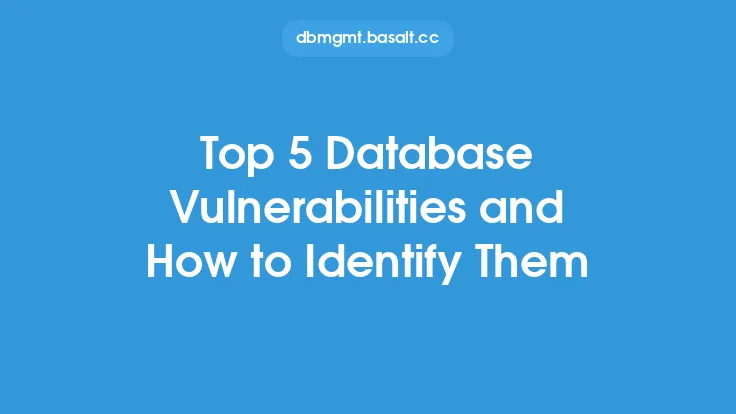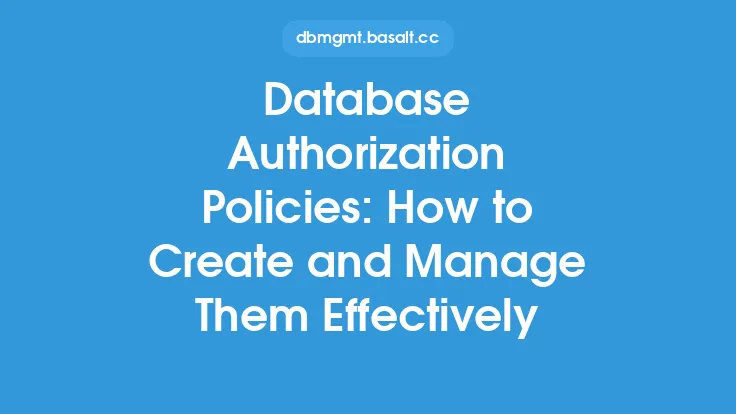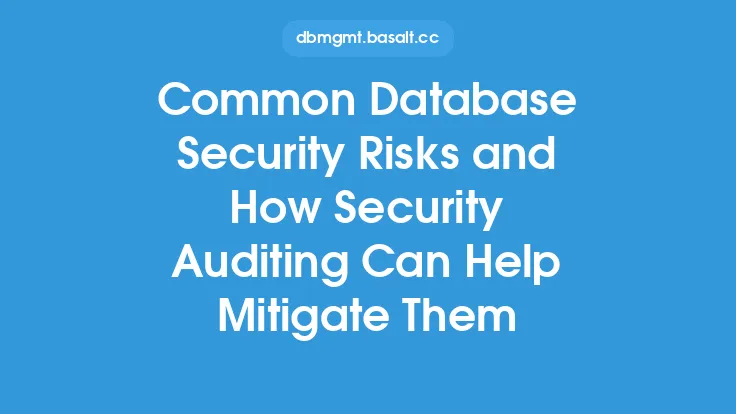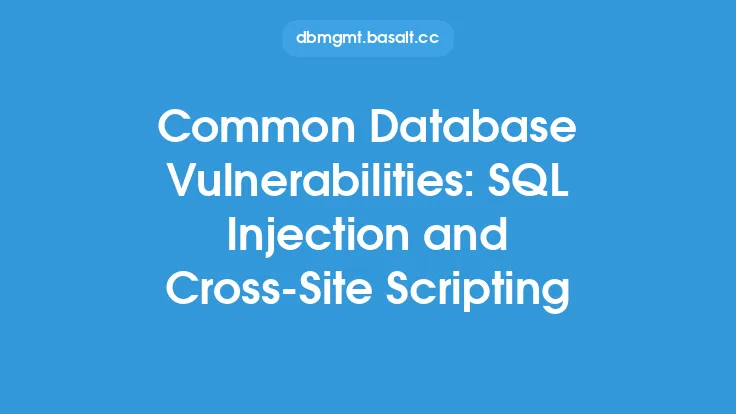Prioritizing and remediating database vulnerabilities is a critical aspect of maintaining the security and integrity of an organization's data. Database vulnerabilities can be exploited by attackers to gain unauthorized access to sensitive information, disrupt business operations, or even take control of the entire system. In this article, we will delve into the process of prioritizing and remediating database vulnerabilities, providing a comprehensive guide on how to identify, assess, and mitigate these vulnerabilities.
Understanding Database Vulnerabilities
Database vulnerabilities refer to weaknesses or flaws in the database management system, its configuration, or the underlying operating system that can be exploited by attackers. These vulnerabilities can be classified into several categories, including:
- Configuration vulnerabilities: These occur when the database is not properly configured, leaving it open to attacks. Examples include weak passwords, outdated software, and misconfigured access controls.
- Design vulnerabilities: These are inherent in the database design and can be exploited by attackers. Examples include SQL injection vulnerabilities and cross-site scripting (XSS) vulnerabilities.
- Operational vulnerabilities: These occur during the operation of the database and can be exploited by attackers. Examples include inadequate logging and monitoring, and insufficient backup and recovery procedures.
Identifying Database Vulnerabilities
Identifying database vulnerabilities is the first step in prioritizing and remediating them. This can be done using various techniques, including:
- Vulnerability scanning: This involves using automated tools to scan the database for known vulnerabilities.
- Penetration testing: This involves simulating an attack on the database to identify vulnerabilities that can be exploited.
- Code reviews: This involves reviewing the database code to identify vulnerabilities and weaknesses.
- Configuration audits: This involves reviewing the database configuration to identify vulnerabilities and weaknesses.
Prioritizing Database Vulnerabilities
Once database vulnerabilities have been identified, they need to be prioritized based on their severity and potential impact. This can be done using various metrics, including:
- CVSS (Common Vulnerability Scoring System) scores: This is a widely used metric that scores vulnerabilities based on their severity and potential impact.
- Risk assessments: This involves assessing the potential risk of each vulnerability and prioritizing them based on their potential impact.
- Business impact: This involves assessing the potential business impact of each vulnerability and prioritizing them based on their potential impact on business operations.
Remediation Strategies
Remediation strategies for database vulnerabilities vary depending on the type and severity of the vulnerability. Some common remediation strategies include:
- Patching: This involves applying patches or updates to fix vulnerabilities in the database software or underlying operating system.
- Configuration changes: This involves making changes to the database configuration to fix vulnerabilities, such as changing passwords or configuring access controls.
- Code changes: This involves making changes to the database code to fix vulnerabilities, such as fixing SQL injection vulnerabilities.
- Compensating controls: This involves implementing compensating controls, such as intrusion detection systems or firewalls, to mitigate the risk of vulnerabilities.
Implementing Remediation Plans
Implementing remediation plans for database vulnerabilities requires careful planning and execution. This involves:
- Developing a remediation plan: This involves developing a plan that outlines the steps to be taken to remediate each vulnerability.
- Assigning resources: This involves assigning resources, such as personnel and equipment, to implement the remediation plan.
- Implementing the plan: This involves implementing the remediation plan, which may involve applying patches, making configuration changes, or making code changes.
- Verifying the fix: This involves verifying that the remediation plan has been successfully implemented and that the vulnerability has been fixed.
Continuous Monitoring and Maintenance
Continuous monitoring and maintenance are critical aspects of prioritizing and remediating database vulnerabilities. This involves:
- Regularly scanning for vulnerabilities: This involves regularly scanning the database for new vulnerabilities and weaknesses.
- Monitoring for suspicious activity: This involves monitoring the database for suspicious activity, such as unusual login attempts or data access patterns.
- Maintaining up-to-date software: This involves maintaining up-to-date software and applying patches and updates as soon as they become available.
- Reviewing and updating configurations: This involves regularly reviewing and updating database configurations to ensure that they are secure and up-to-date.
Best Practices
Some best practices for prioritizing and remediating database vulnerabilities include:
- Implementing a vulnerability management program: This involves implementing a program that identifies, assesses, and mitigates database vulnerabilities on an ongoing basis.
- Using automated tools: This involves using automated tools, such as vulnerability scanners and patch management tools, to identify and remediate vulnerabilities.
- Providing training and awareness: This involves providing training and awareness to database administrators and other personnel on database security and vulnerability management.
- Continuously monitoring and maintaining the database: This involves continuously monitoring and maintaining the database to ensure that it is secure and up-to-date.
Conclusion
Prioritizing and remediating database vulnerabilities is a critical aspect of maintaining the security and integrity of an organization's data. By understanding database vulnerabilities, identifying and prioritizing them, and implementing remediation plans, organizations can reduce the risk of data breaches and other security incidents. Continuous monitoring and maintenance are also critical aspects of prioritizing and remediating database vulnerabilities, as they help to ensure that the database remains secure and up-to-date over time. By following best practices and using automated tools, organizations can ensure that their databases are secure and protected from vulnerabilities and other security threats.





